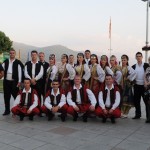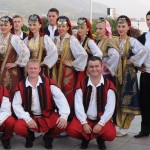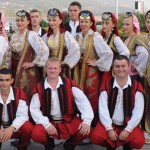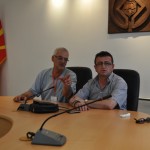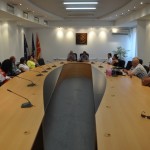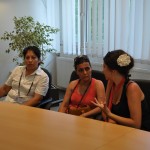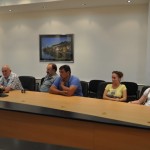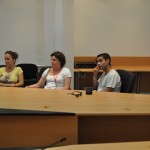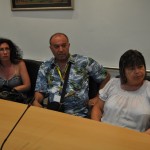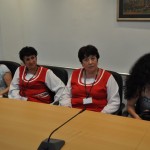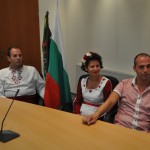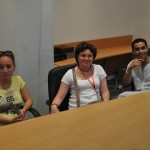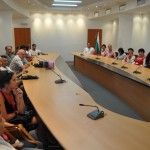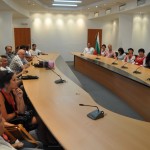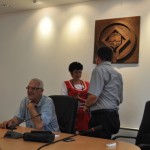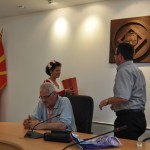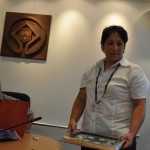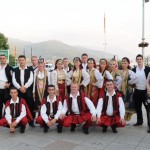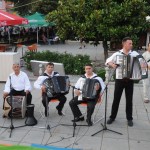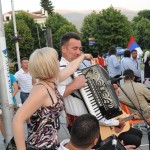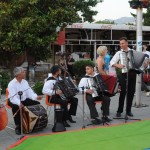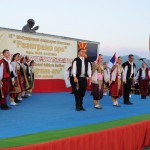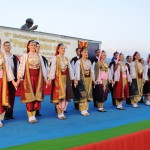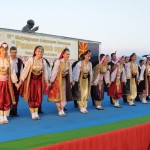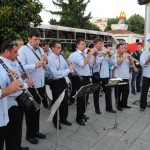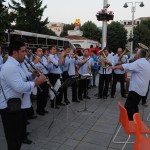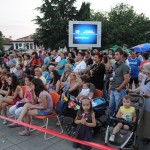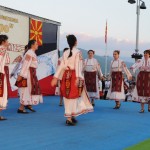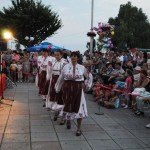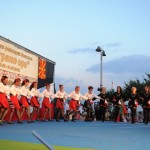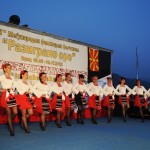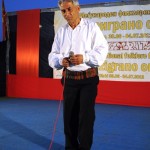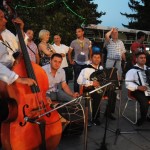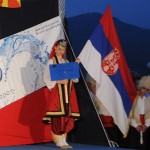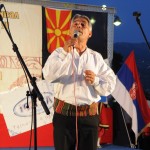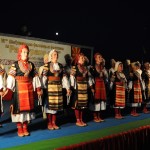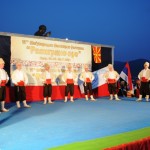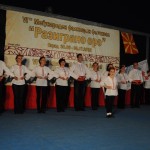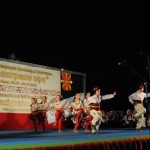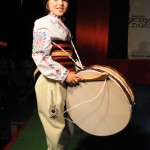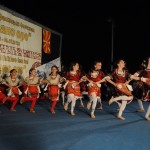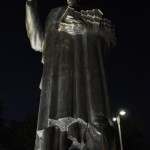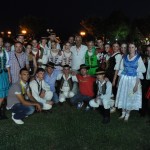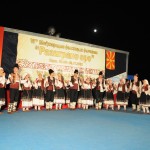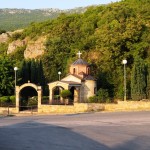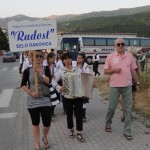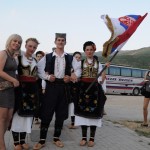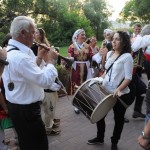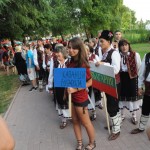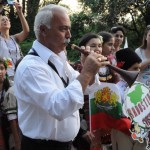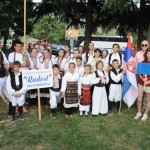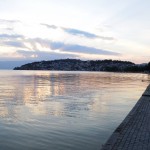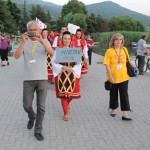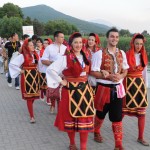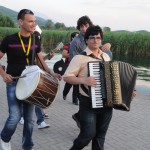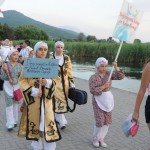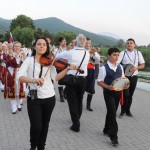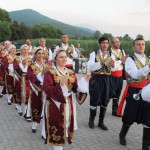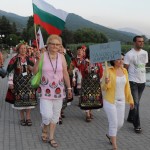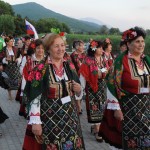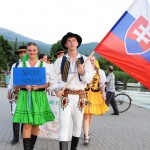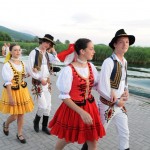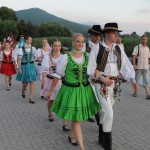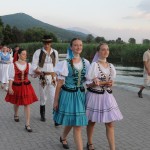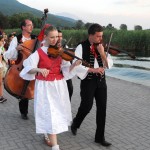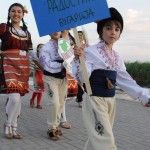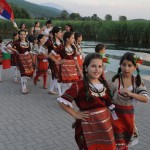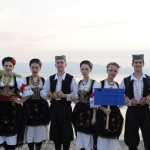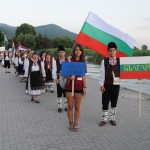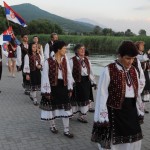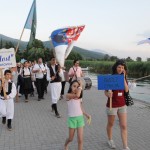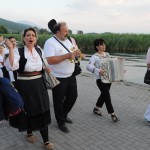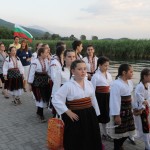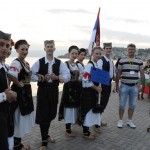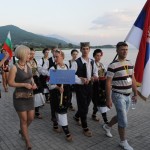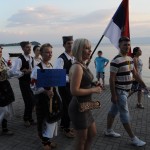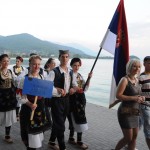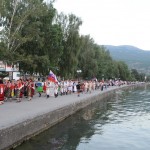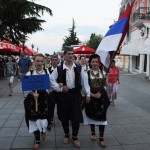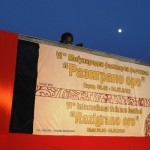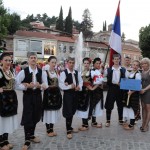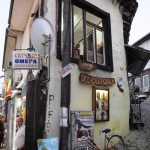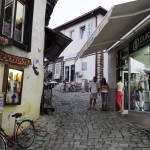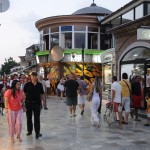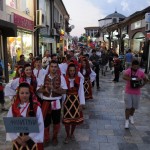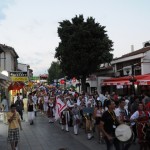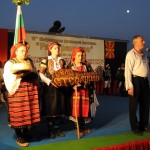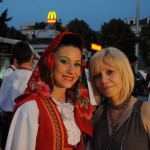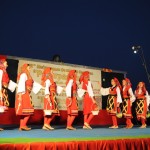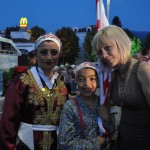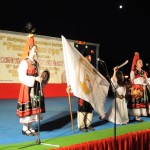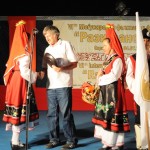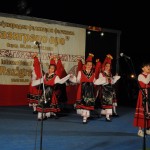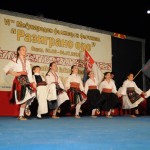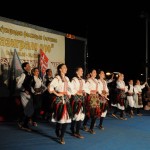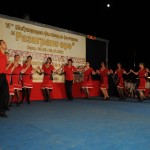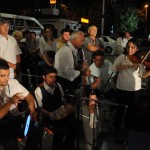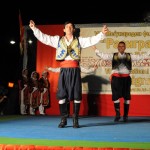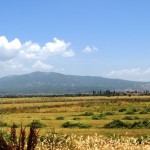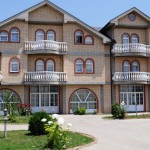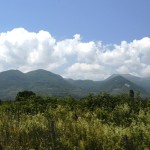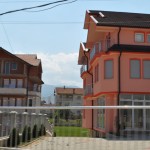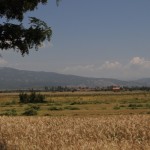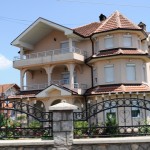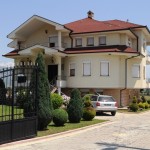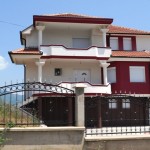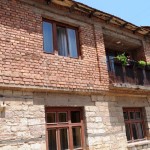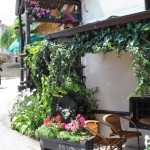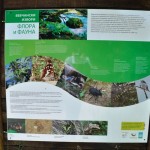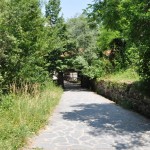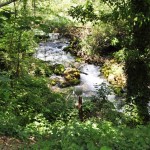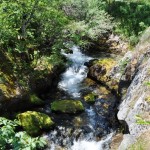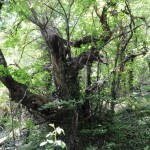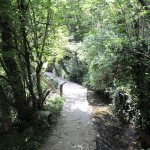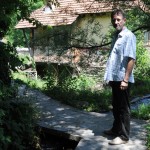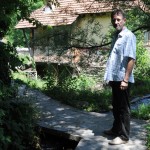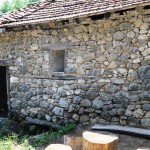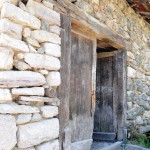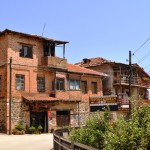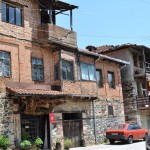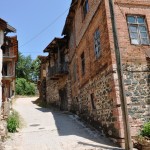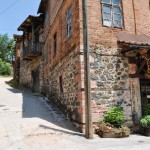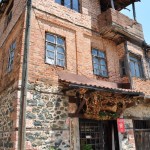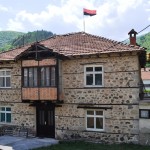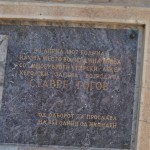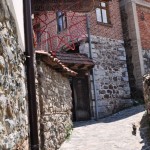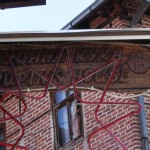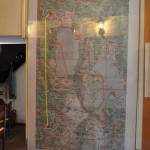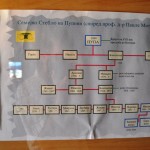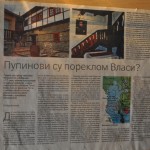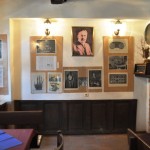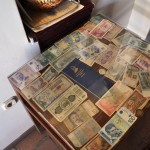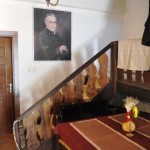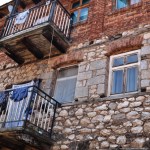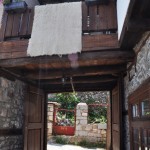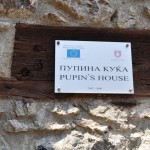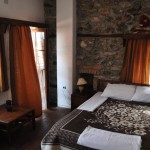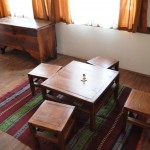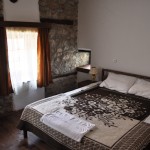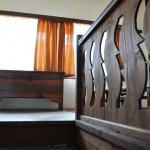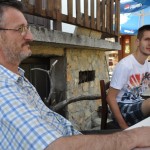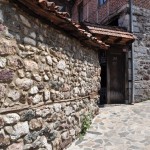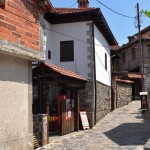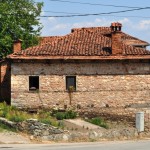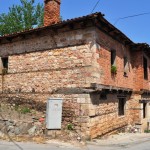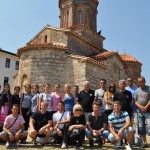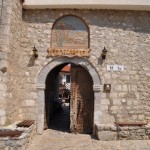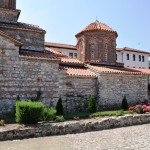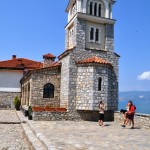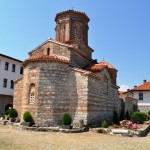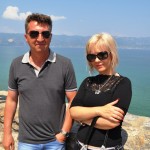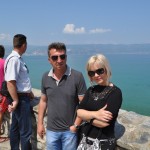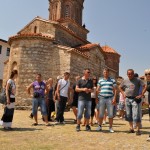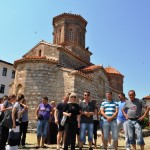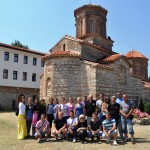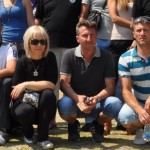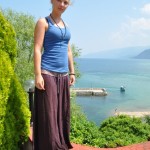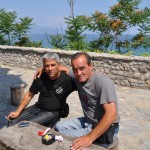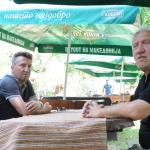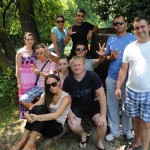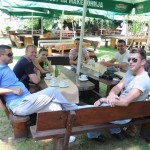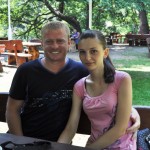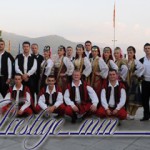Ispred Prestige_MM na festivalu nastupio FA „Venac“ Gračanica, Srbija
Ohrid (Macedonian: Охрид) is a city on the eastern shore of Lake Ohrid in the Republic of Macedonia. It has about 42,000 inhabitants, making it the seventh largest city in the country. The city is the seat of Ohrid Municipality. Ohrid is notable for having 365 churches, one for each day of the year and has been referred to as a „Jerusalem“. The city is rich in picturesque houses and monuments, and tourism is predominant. It is located southwest of Skopje, west of Resen and Bitola, close to the border with Albania. In 1979 and in 1980, Ohrid and Lake Ohrid were accepted as a Cultural and Natural World Heritage Sites by UNESCO. In fact, Ohrid is one of only 28 sites that are part of UNESCO’s World Heritage that are both Cultural and Natural sites.
Geography
Ohrid is located in the south-western part of Macedonia, on the banks of Lake Ohrid, at an elevation of 690 meters above sea level.
History
Ancient
The earliest inhabitants of the widest Lake Ohrid region were tribes of Illyrian origin, the Dassaretae and Encheleans. According to recent excavations by Macedonian archaeologists it was a town way back at the time of king Phillip II of Macedon. They allege that Samuil’s Fortress was built on the place of an earlier fortification, dated to 4th century B.C. During the Roman conquests, towards the end of 3rd and the beginning of 2nd century BC, the Dassaretaeand the region Dassaretia were mentioned, as well as the town of Lychnidos. The existence of the ancient town of Lychnidos is linked to the Greek myth of the Phoenician prince Cadmus who, banished from Thebes, in Boetia, fled to the Enchelei and founded the town of Lychnidos on the shores of Lake Ohrid. The Lake of Ohrid, the ancient Lacus Lychnitis, whose blue and exceedingly transparent waters in remote antiquity gave to the lake its Greek name; it was still called so occasionally in the Middle Ages. It was located along the Via Egnatia, which connected the Adriatic port Dyrrachion (present-day Durrës) with Byzantium. Archaeological excavations (e.g., the Polyconch Basilica from 5th century) prove early adoption of Christianity in the area. Bishops from Lychnidos participated in multiple ecumenical councils.
Medieval
The South Slavs began to arrive in the area during the 6th century AD. Until the early 7th century it was colonized by the tribe of Berziti. The Bulgars conquered the city in 867. The name Ohrid first appeared in 879. Between 990 and 1015, Ohrid was the capital and stronghold of the Bulgarian Empire. From 990 to 1018 Ohrid was also the seat of the Bulgarian Patriarchate. After the Byzantine reconquest of the city in 1018 by Basil II, theBulgarian Patriarchate was downgraded to an Archbishopric and placed under the authority of the Ecumenical Patriarch of Constantinople.
The higher clergy after 1018 was almost invariably Greek, including during the period of Ottoman domination, until the abolition of the archbishopric in 1767. At the beginning of the 16th century the archbishopric reached its peak subordinating the Sofia, Vidin, Vlachand Moldavian eparchies, part of the former Serbian Orthodox Peć Patriarchate (including Peć itself), and even the Orthodox districts of Italy (Apulia, Calabria and Sicily), Veniceand Dalmatia.
As an episcopal city, Ohrid was an important cultural center. Almost all surviving churches were built by the Byzantines and by the Bulgarians, the rest of them date back to the short time of Serbian rule during the late Middle Ages.
Bohemond leading an Norman army took the city in 1083. In the 13th and 14th century the city changed hands between the Despotate of Epirus, the Bulgarian, the Byzantine and the Serbian Empire and local Albanian rulers. In the middle of the 13th century Ohrid was one of the cities ruled by Paul Gropa, a member of the Albanian noble Gropa family. In 1334 the city was captured by Stefan Uroš IV Dušan and incorporated in the Serbian Empire. After Dusan’s death the city came under the control of Andrea Gropa, while after his death Prince Marko incorporated it in the Kingdom of Prilep. In the early 1370s Marko lost Ohrid to Paul II Gropa, another member of the Gropa family and unsuccessfully tried to recapture it in 1375 with Ottoman assistance. In 1395 the Ottomans under Bayezid I captured the city which became the seat of the newly established Sanjak of Ohrid. In September 14-5, 1464 12,000 troops of the League of Lezhë and 1,000 of the Republic of Venice defeated a 14,000-man Ottoman force near the city. When Mehmed II returned from Albania after his actions against Skanderbeg in 1466 he dethroned Dorotheos, the Archbishop of Ohrid, and expatriated him together with his clerks and boyars and considerable number of citizens of Ohrid to Istanbul, probably because of their anti-Ottoman activities during Skanderbeg’s rebellion when many citizens of Ohrid, including Dorotheos and his clergy, supported Skanderbeg and his fight.
Modern
The house of the wealthy Robevi family.
The Christian population declined during the first centuries of Ottoman rule. In 1664 there were only 142 Christian houses. The situation changed in the 18th century when Ohrid emerged as an important trade center on a major trade route. At the end of this century it had around five thousand inhabitants. Towards the end of the 18th century and in the early part of the 19th century, Ohrid region, like other parts of European Turkey, was a hotbed of unrest. In the 19th century the region of Ohrid became part of the Pashalik of Scutari, ruled by the Bushatifamily. By the end of 19th century Ohrid had 2409 houses with 11900 inhabitants out of which 45% were Muslims while the rest was mainly Roman Catholic and Orthodox Christian. Before 1912, Ohrid was a township center bounded to Monastir Sanjak in Monastir province (present-day Bitola). The city remained under the Ottomans until 1912, when the Serbian army took control of the city. In September 1913 local Albanian and pro-Bulgarian Internal Macedonian Revolutionary Organization leaders rebelledagainst the Kingdom of Serbia.
Demographics
As of the 2002 census, the city of Ohrid has 42,033 inhabitants and the ethnic composition was the following:
Macedonians, 33,791 (80.4%)
Albanians, 2,959 (7.0%)
Turks, 2,256 (5.4%)
others, 3,027 (7.2%)
Church of St. Sophia, Ohrid
The Church of St. Sophia (Macedonian: Црква Света Софија, Crkva Sveta Sofija) is located in the city of Ohrid, Republic of Macedonia. The church is one of the most important monuments of Macedonia, housing architecture and art from the Middle Ages. It was built during the First Bulgarian Empire, after the official conversion to Christianity. Some sources date the building of the church during the rule of Knyaz Boris I (852 – 889), others during the rule of empire Samuel of Bulgaria (997 – 1014).
Originally the synod church of the Archbishopric of Ohrid, it was later converted into a mosque during the rule of the Ottoman Empire. The interior of the church has been preserved with frescoes from the 11th, 12th and 13th century, which represent some of the most significant achievements in Byzantine painting of the time. The main part of the church was built in the 11th century, while external additions were built by Archbishop Grigorie in the 14th century.
In November 2009, Macedonian Orthodox Church introduced a new Coat of Arms with church of St. Sophia as a charge on the shield.
A detail from the church is depicted on the reverse of the Macedonian 1000 denars banknote, issued in 1996 and 2003.
Saint Naum
Saint Naum (Macedonian: Свети Наум, Sveti Naum), also known as Naum of Ohrid or Naum of Preslav (c. 830 – December 23, 910) was a medieval Bulgarian scholar and missionary among the Slavs. He is venerated as a saint in the Orthodox Church.
Information about his early life is scarce. According to the hagiography of Saint Cyril and Methodius by Clement of Ohrid, Naum took part in the historic mission to Moravia together with Cyril, Methodius, Clement, Angelarius, Gorazd and other Slavic missionaries in 863. In 867 or 868 he became a priest in Rome. For the next 22 years, he worked with Cyril and Methodius and other missionaries in translating the Bible into Old Church Slavonic and promoted it in Great Moravia and Pannonia. For the purpose of the mission to Moravia, the missionaries devised the Glagolitic alphabet, the first alphabet to match the specific features of the Slavic language. Its descendant script, Cyrillic, is still used by many languages today. The missionaries also wrote the first Slavic Civil Code, which was used in Great Moravia.
However, the missionary work ran into opposition from German clerics who opposed their efforts to create a Slavic liturgy. By 885, the two main patrons for the missionaries, Rastislav of Great Moravia and Prince Koceľ of Pannonia, as well as Cyril and Methodius had died, and the pressure from the German church became increasingly more hostile. After a brief period of imprisonment due to the ongoing conflict with the German clerics, Naum, together with some of the missionaries headed to Bulgaria, then ruled by Tsar Boris. Boris converted to Christianity in 864 and was named Michael after his godfather, Emperor Michael III. Naum moved to the capital Pliska together with Clement, Angelarius and possibly Gorazd (according to other sources, Gorazd was already dead by that time).
Naum was one of the founders of the Pliska Literary School (later Preslav Literary School) where he worked between 886 and 893. The most reliable first-hand account of the activities at the time in Pliska is „An Account of Letters“ (O pismenech), a treatise on Slavic literacy written in Old Church Slavonic, thought to be composed shortly after 893. The piece calls for the creation of a common Slavic alphabet.
After Clement was ordained bishop of Drembica and Velika in 893, Naum continued Clement’s work at Ohrid, another important centre of Slavic learning. In 905 Naum founded a monastery on the shores of Lake Ohrid, which later received his name.
St. Naum Peak on Livingston Island in the South Shetland Islands, Antarctica is named for Saint Naum.
The Monastery of Saint Naum is an Eastern Orthodox monastery in the Republic of Macedonia, named after the medieval Saint Naum who founded it. It is situated along Lake Ohrid, 29 kilometres (18 mi) south of the city of Ohrid.
The Lake Ohrid area, including St Naum, is one of the most popular tourist destinations in Macedonia.
The monastery was established in the year 905 by St Naum of Ohrid himself. St Naum is also buried in the church.
The area where the monastery of St Naum lies belonged to Albania for a short period from 1912 until June 28, 1925, when Zog of Albania ceded it to Yugoslavia as a result of negotiations between Albania and Yugoslavia and as a gesture of good will.
Struga
Struga (Macedonian: Струга) is a town and popular tourist destination situated in the south-western region of the Republic of Macedonia, lying on the shore of Lake Ohrid. The town of Struga is the seat of Struga Municipality.
Struga is located in an open valley on Lake Ohrid. The Black Drim river starts at the lake and divides the city.
As of the 2002 census, the city of Struga has 16,559 inhabitants and the ethnic composition was the following:
Macedonians, 8,901 (53.7%)
Albanians, 5,293 (31,9%)
Turks, 907 (5.5%)
Vlachs, 550 (3.3%)
others, 908 (5.5%)
Vevčani
Vevčani (Macedonian: Вевчани) is a small city in Republic of Macedonia. It is the only settlement and seat of Vevčani Municipality.
The village of Vevčani is found in the southwestern range at the foot of the Jablanica mountain range. It is situated from 800 – 950 metres above sea level. The village is located 14 km North-West of the town of Struga. The village is situated near the villages of Oktisi, Velešta, Podgorci, Gorna Belica with the Albanian border to the West of the village.
Early history
It was believed that the village of Vevčani was founded sometime during period from the end of the 6th century to the beginning of the 8th century. The village was founded most probably by Berziti, who had adopted Christianity. The first settlement was originally at the foot of the Jablanica mountain. It was believed to have been founded in a place known as Selište. However, newest archaeological researches show that the village was there at least in second century B.C. It can not be excluded that somewere in 6th century newly settled village Seliste merged with the long existing village. Crucial fact is that right above the village remainings of Romancamp have been found, and history states that Romans usually camped near villages to be able to get supplies.
After the Battle of Kosovo, the area was under Ottoman rule for many centuries.
After the Balkans Wars the village of Vevčani fell under Serbian rule. It was a part of the Vardar Banovina before it was captured during the Invasion of Yugoslavia by Albanian forces. The name of the village was officially changed to Veçani. A group of partisans was created in Vevčani on 17 September 1944. The group liberated the village as a part of the „Drimkol“ group of partisans.
Vevcani is home to the „Parish of Vevčani“ which also includes the villages of Oktisi and Gorna Belica. For centuries the village has been a Christian village surrounded by many Muslim villages. The village is home to 19 Churches, Monasteries and Chapels. The central church of the village however is Saint Nikola which dates back from 1876. A prominent monastery is Sveti Spas which is situated at over 1300 metres above sea level.
In an 1509 defter, the village was part of the Ohrid vilayet, and had 208 households. In 1519, the village had 223 households. In 1634 it was registered under the name Vevčani with a total of 134 households. The French ethnographic study of Macedonia conducted in 1878, Ethnography of the vilayets of Adrianople, of Monastir and of Salonica, counted the village as having 865 houses and 2430 inhabitants, which at the time were considered Bulgarians. Vasil Kanchov’s study of Macedonia in 1900, Macedonia, Ethnography and Statistics, counted the village as having 2590 Bulgarian inhabitants. A study conducted in 1907 had counted 440 households with 2,347 inhabitants. In 1910, a Serbian commune of the Ecumenical Patriarchate of Constantinople numbered 17 households which were ethnically Serbian in the village. The 1994 census counted 2,448 inhabitants as residing in the village.
According to the 2002 Macedonian census the population of Vevčani was 2,433. In 2002 there were 593 households present in Vevčani. Of the 2,433 inhabitants, 1,229 were Males while 1,204 were females. The ethnic composition was as follows:
Macedonians – 2,419 (99.43%)
Albanians – 3 (0.12%)
Serbs – 3 (0.12%)
Aromanians – 1 (0.04%)
Others – 7 (0.28%)
We recommend you to visit museum City on water(entrence 80 denars per person), and you can also drive around whole Ohrid lake.







